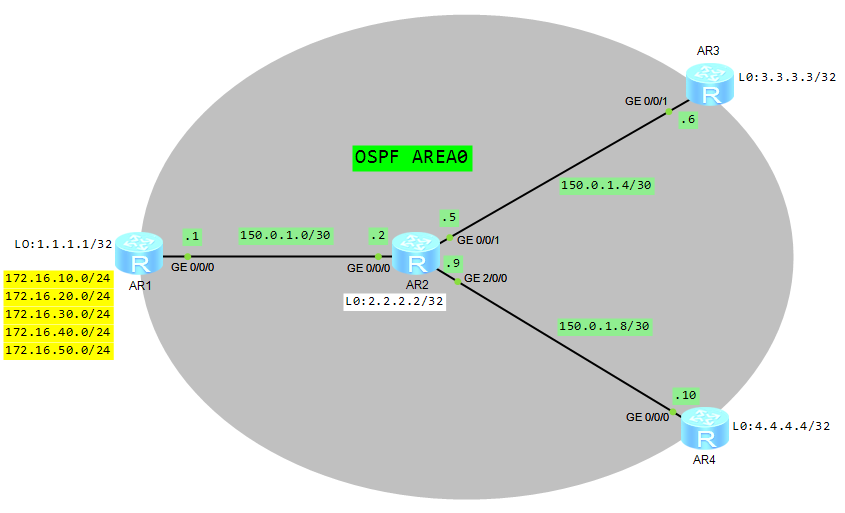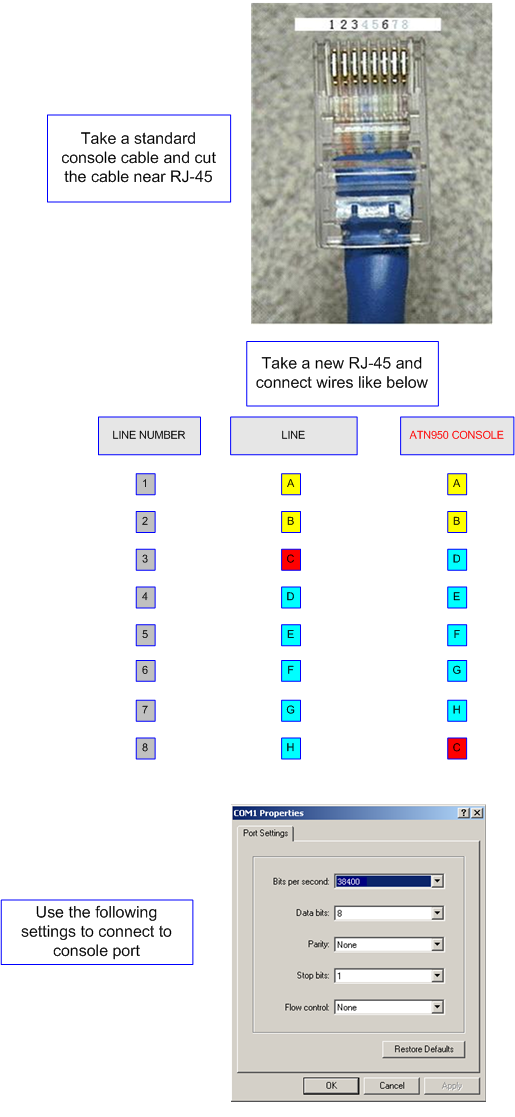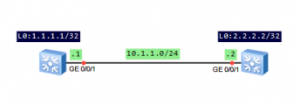How to filter advertised and received routes on Huawei router?
Let’s try to check it based on the following topology:

- Configure basic OSPF functions on all routers.
- Configure static routes on AR1 router and import them to OSPF.
- Use filter-policy for advertised routes on AR1.
- Use filter-policy for received routes on AR3.
OSPF configuration (AR2 as an example):
[AR2]dis cur config ospf
#
ospf 1
area 0.0.0.0
network 2.2.2.2 0.0.0.0
network 150.0.1.0 0.0.0.3
network 150.0.1.4 0.0.0.3
network 150.0.1.8 0.0.0.3
Configure static routes on AR1:
[AR1]ip route-static 172.16.10.0 255.255.255.0 NULL0
[AR1]ip route-static 172.16.20.0 255.255.255.0 NULL0
[AR1]ip route-static 172.16.30.0 255.255.255.0 NULL0
[AR1]ip route-static 172.16.40.0 255.255.255.0 NULL0
[AR1]ip route-static 172.16.50.0 255.255.255.0 NULL0
Import these routes to OSPF:
[AR1]ospf
[AR1-ospf-1]import-route static
Check IP routing tables of AR2, AR3 and AR4 routers:
[AR2]dis ip routing-table
Route Flags: R - relay, D - download to fib
------------------------------------------------------------------------------
Routing Tables: Public
Destinations : 22 Routes : 22
Destination/Mask Proto Pre Cost Flags NextHop Interface
1.1.1.1/32 OSPF 10 1 D 150.0.1.1 GigabitEthernet0/0/0
2.2.2.2/32 Direct 0 0 D 127.0.0.1 LoopBack0
3.3.3.3/32 OSPF 10 1 D 150.0.1.6 GigabitEthernet0/0/1
4.4.4.4/32 OSPF 10 1 D 150.0.1.10 GigabitEthernet2/0/0
127.0.0.0/8 Direct 0 0 D 127.0.0.1 InLoopBack0
127.0.0.1/32 Direct 0 0 D 127.0.0.1 InLoopBack0
127.255.255.255/32 Direct 0 0 D 127.0.0.1 InLoopBack0
150.0.1.0/30 Direct 0 0 D 150.0.1.2 GigabitEthernet0/0/0
150.0.1.2/32 Direct 0 0 D 127.0.0.1 GigabitEthernet0/0/0
150.0.1.3/32 Direct 0 0 D 127.0.0.1 GigabitEthernet0/0/0
150.0.1.4/30 Direct 0 0 D 150.0.1.5 GigabitEthernet0/0/1
150.0.1.5/32 Direct 0 0 D 127.0.0.1 GigabitEthernet0/0/1
150.0.1.7/32 Direct 0 0 D 127.0.0.1 GigabitEthernet0/0/1
150.0.1.8/30 Direct 0 0 D 150.0.1.9 GigabitEthernet2/0/0
150.0.1.9/32 Direct 0 0 D 127.0.0.1 GigabitEthernet2/0/0
150.0.1.11/32 Direct 0 0 D 127.0.0.1 GigabitEthernet2/0/0
172.16.10.0/24 O_ASE 150 1 D 150.0.1.1 GigabitEthernet0/0/0
172.16.20.0/24 O_ASE 150 1 D 150.0.1.1 GigabitEthernet0/0/0
172.16.30.0/24 O_ASE 150 1 D 150.0.1.1 GigabitEthernet0/0/0
172.16.40.0/24 O_ASE 150 1 D 150.0.1.1 GigabitEthernet0/0/0
172.16.50.0/24 O_ASE 150 1 D 150.0.1.1 GigabitEthernet0/0/0
255.255.255.255/32 Direct 0 0 D 127.0.0.1 InLoopBack0
[AR3]dis ip routing-table
Route Flags: R - relay, D - download to fib
------------------------------------------------------------------------------
Routing Tables: Public
Destinations : 18 Routes : 18
Destination/Mask Proto Pre Cost Flags NextHop Interface
1.1.1.1/32 OSPF 10 2 D 150.0.1.5 GigabitEthernet0/0/1
2.2.2.2/32 OSPF 10 1 D 150.0.1.5 GigabitEthernet0/0/1
3.3.3.3/32 Direct 0 0 D 127.0.0.1 LoopBack0
4.4.4.4/32 OSPF 10 2 D 150.0.1.5 GigabitEthernet0/0/1
127.0.0.0/8 Direct 0 0 D 127.0.0.1 InLoopBack0
127.0.0.1/32 Direct 0 0 D 127.0.0.1 InLoopBack0
127.255.255.255/32 Direct 0 0 D 127.0.0.1 InLoopBack0
150.0.1.0/30 OSPF 10 2 D 150.0.1.5 GigabitEthernet0/0/1
150.0.1.4/30 Direct 0 0 D 150.0.1.6 GigabitEthernet0/0/1
150.0.1.6/32 Direct 0 0 D 127.0.0.1 GigabitEthernet0/0/1
150.0.1.7/32 Direct 0 0 D 127.0.0.1 GigabitEthernet0/0/1
150.0.1.8/30 OSPF 10 2 D 150.0.1.5 GigabitEthernet0/0/1
172.16.10.0/24 O_ASE 150 1 D 150.0.1.5 GigabitEthernet0/0/1
172.16.20.0/24 O_ASE 150 1 D 150.0.1.5 GigabitEthernet0/0/1
172.16.30.0/24 O_ASE 150 1 D 150.0.1.5 GigabitEthernet0/0/1
172.16.40.0/24 O_ASE 150 1 D 150.0.1.5 GigabitEthernet0/0/1
172.16.50.0/24 O_ASE 150 1 D 150.0.1.5 GigabitEthernet0/0/1
255.255.255.255/32 Direct 0 0 D 127.0.0.1 InLoopBack0
[AR4]dis ip routing-table
Route Flags: R - relay, D - download to fib
------------------------------------------------------------------------------
Routing Tables: Public
Destinations : 18 Routes : 18
Destination/Mask Proto Pre Cost Flags NextHop Interface
1.1.1.1/32 OSPF 10 2 D 150.0.1.9 GigabitEthernet0/0/0
2.2.2.2/32 OSPF 10 1 D 150.0.1.9 GigabitEthernet0/0/0
3.3.3.3/32 OSPF 10 2 D 150.0.1.9 GigabitEthernet0/0/0
4.4.4.4/32 Direct 0 0 D 127.0.0.1 LoopBack0
127.0.0.0/8 Direct 0 0 D 127.0.0.1 InLoopBack0
127.0.0.1/32 Direct 0 0 D 127.0.0.1 InLoopBack0
127.255.255.255/32 Direct 0 0 D 127.0.0.1 InLoopBack0
150.0.1.0/30 OSPF 10 2 D 150.0.1.9 GigabitEthernet0/0/0
150.0.1.4/30 OSPF 10 2 D 150.0.1.9 GigabitEthernet0/0/0
150.0.1.8/30 Direct 0 0 D 150.0.1.10 GigabitEthernet0/0/0
150.0.1.10/32 Direct 0 0 D 127.0.0.1 GigabitEthernet0/0/0
150.0.1.11/32 Direct 0 0 D 127.0.0.1 GigabitEthernet0/0/0
172.16.10.0/24 O_ASE 150 1 D 150.0.1.9 GigabitEthernet0/0/0
172.16.20.0/24 O_ASE 150 1 D 150.0.1.9 GigabitEthernet0/0/0
172.16.30.0/24 O_ASE 150 1 D 150.0.1.9 GigabitEthernet0/0/0
172.16.40.0/24 O_ASE 150 1 D 150.0.1.9 GigabitEthernet0/0/0
172.16.50.0/24 O_ASE 150 1 D 150.0.1.9 GigabitEthernet0/0/0
255.255.255.255/32 Direct 0 0 D 127.0.0.1 InLoopBack0
As you can see, all static routes imported to OSPF are available as O_ASE.
Now we can filter routes advertised by AR1 router. Only three routes will be advertised: 172.16.10.0/24, 172.16.20.0/24 and 172.16.30.0/24.
Create IP prefix list named AR1toAR2 and permit these 3 routes:
[AR1]ip ip-prefix AR1toAR2 index 10 permit 172.16.10.0 24
[AR1]ip ip-prefix AR1toAR2 index 20 permit 172.16.20.0 24
[AR1]ip ip-prefix AR1toAR2 index 30 permit 172.16.30.0 24
Apply filter-policy to OSPF:
[AR1]ospf
[AR1-ospf-1]filter-policy ip-prefix AR1toAR2 export
Check IP routing table, for instance AR2:
[AR2]dis ip routing-table
Route Flags: R - relay, D - download to fib
------------------------------------------------------------------------------
Routing Tables: Public
Destinations : 20 Routes : 20
Destination/Mask Proto Pre Cost Flags NextHop Interface
1.1.1.1/32 OSPF 10 1 D 150.0.1.1 GigabitEthernet0/0/0
2.2.2.2/32 Direct 0 0 D 127.0.0.1 LoopBack0
3.3.3.3/32 OSPF 10 1 D 150.0.1.6 GigabitEthernet0/0/1
4.4.4.4/32 OSPF 10 1 D 150.0.1.10 GigabitEthernet2/0/0
127.0.0.0/8 Direct 0 0 D 127.0.0.1 InLoopBack0
127.0.0.1/32 Direct 0 0 D 127.0.0.1 InLoopBack0
127.255.255.255/32 Direct 0 0 D 127.0.0.1 InLoopBack0
150.0.1.0/30 Direct 0 0 D 150.0.1.2 GigabitEthernet0/0/0
150.0.1.2/32 Direct 0 0 D 127.0.0.1 GigabitEthernet0/0/0
150.0.1.3/32 Direct 0 0 D 127.0.0.1 GigabitEthernet0/0/0
150.0.1.4/30 Direct 0 0 D 150.0.1.5 GigabitEthernet0/0/1
150.0.1.5/32 Direct 0 0 D 127.0.0.1 GigabitEthernet0/0/1
150.0.1.7/32 Direct 0 0 D 127.0.0.1 GigabitEthernet0/0/1
150.0.1.8/30 Direct 0 0 D 150.0.1.9 GigabitEthernet2/0/0
150.0.1.9/32 Direct 0 0 D 127.0.0.1 GigabitEthernet2/0/0
150.0.1.11/32 Direct 0 0 D 127.0.0.1 GigabitEthernet2/0/0
172.16.10.0/24 O_ASE 150 1 D 150.0.1.1 GigabitEthernet0/0/0
172.16.20.0/24 O_ASE 150 1 D 150.0.1.1 GigabitEthernet0/0/0
172.16.30.0/24 O_ASE 150 1 D 150.0.1.1 GigabitEthernet0/0/0
255.255.255.255/32 Direct 0 0 D 127.0.0.1 InLoopBack0
From the output you can noticed that only three routes are advertised by AR1.
Now configure filter-policy for routes received by AR3.
Create IP prefix list on AR3 that permits only 172.16.10.0/24 route:
[AR3]ip ip-prefix AR2toAR3 index 10 permit 172.16.10.0 24
Apply filter-policy to OSPF as import:
[AR3]ospf
[AR3-ospf-1]filter-policy ip-prefix AR2toAR3 import
Check routing table of AR3 router:
[AR3]dis ip routing-table
Route Flags: R - relay, D - download to fib
------------------------------------------------------------------------------
Routing Tables: Public
Destinations : 9 Routes : 9
Destination/Mask Proto Pre Cost Flags NextHop Interface
3.3.3.3/32 Direct 0 0 D 127.0.0.1 LoopBack0
127.0.0.0/8 Direct 0 0 D 127.0.0.1 InLoopBack0
127.0.0.1/32 Direct 0 0 D 127.0.0.1 InLoopBack0
127.255.255.255/32 Direct 0 0 D 127.0.0.1 InLoopBack0
150.0.1.4/30 Direct 0 0 D 150.0.1.6 GigabitEthernet0/0/1
150.0.1.6/32 Direct 0 0 D 127.0.0.1 GigabitEthernet0/0/1
150.0.1.7/32 Direct 0 0 D 127.0.0.1 GigabitEthernet0/0/1
172.16.10.0/24 O_ASE 150 1 D 150.0.1.5 GigabitEthernet0/0/1
255.255.255.255/32 Direct 0 0 D 127.0.0.1 InLoopBack0
Check IP routing table of AR4 router:
[AR4]dis ip routing-table
Route Flags: R - relay, D - download to fib
------------------------------------------------------------------------------
Routing Tables: Public
Destinations : 16 Routes : 16
Destination/Mask Proto Pre Cost Flags NextHop Interface
1.1.1.1/32 OSPF 10 2 D 150.0.1.9 GigabitEthernet0/0/0
2.2.2.2/32 OSPF 10 1 D 150.0.1.9 GigabitEthernet0/0/0
3.3.3.3/32 OSPF 10 2 D 150.0.1.9 GigabitEthernet0/0/0
4.4.4.4/32 Direct 0 0 D 127.0.0.1 LoopBack0
127.0.0.0/8 Direct 0 0 D 127.0.0.1 InLoopBack0
127.0.0.1/32 Direct 0 0 D 127.0.0.1 InLoopBack0
127.255.255.255/32 Direct 0 0 D 127.0.0.1 InLoopBack0
150.0.1.0/30 OSPF 10 2 D 150.0.1.9 GigabitEthernet0/0/0
150.0.1.4/30 OSPF 10 2 D 150.0.1.9 GigabitEthernet0/0/0
150.0.1.8/30 Direct 0 0 D 150.0.1.10 GigabitEthernet0/0/0
150.0.1.10/32 Direct 0 0 D 127.0.0.1 GigabitEthernet0/0/0
150.0.1.11/32 Direct 0 0 D 127.0.0.1 GigabitEthernet0/0/0
172.16.10.0/24 O_ASE 150 1 D 150.0.1.9 GigabitEthernet0/0/0
172.16.20.0/24 O_ASE 150 1 D 150.0.1.9 GigabitEthernet0/0/0
172.16.30.0/24 O_ASE 150 1 D 150.0.1.9 GigabitEthernet0/0/0
255.255.255.255/32 Direct 0 0 D 127.0.0.1 InLoopBack0
As you can see only one route is received by AR3. So filter-policy works correctly. AR4 router still receives all three routes.
Read More »
 Labnario Huawei From Scratch
Labnario Huawei From Scratch





